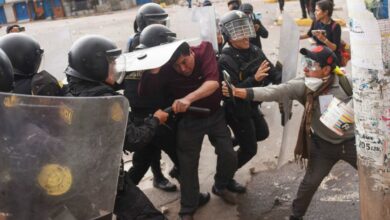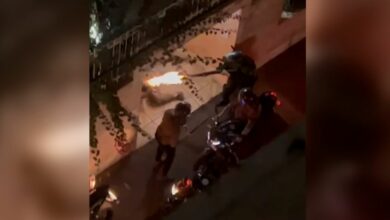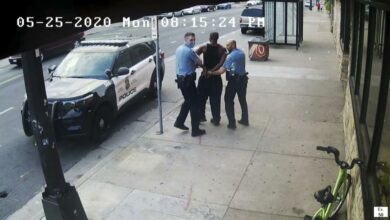As the photojournalists’ division of the Egyptian Press Syndicate commences its second term following elections held last Saturday, 27 March–a term that will witness politically-sensitive presidential, parliamentary and Shura council elections–its primary challenges of combating State Security aggression and developing its members’ professional skills have become more pressing than ever.
The division, comprised of 51 active syndicate members, was borne out of frustration in response to ongoing police brutality. According to Hossam Diab, Al-Masry Al-Youm’s photo editor and the division’s chairman, half-hearted attempts to form a division, which began as early as 2000, never bore fruit because of a lack of seriousness on the part of those involved. Increased violations against photographers by security forces, however, would eventually shake them out of their passivity.
The politically charged presidential and parliamentary elections of 2005 were marked by often excessive abuses against journalists by State Security. While covering the elections, Associated Press photographer Amr Nabil lost an eye when he was struck by a brick thrown by a member of the security forces. Such aggression, coupled with a short-fused confrontational tone, continued unchecked, and in early 2007 a turning point was reached when news photographers were excluded from parliament after an Al-Masry Al-Youm photographer captured Prime Minister Ahmed Nazif eating watermelon seeds. In response, the photographers staged a demonstration on the front steps of the Journalists’ Syndicate, protesting the persistent attacks on them.
Banded together, the photojournalists soon thereafter seized the opportunity to form their own division at the Journalists’ Syndicate. They held their first term elections in the same month, electing Diab as chairman and Nabil as deputy chairman by recommendation, and voted on the remaining three members.
The following year saw no easing of State Security transgressions against photojournalists, especially those covering the Deweiqa rockslide and the fires at the National Theater and the Shura Council building. Incensed at the persistently confrontational attitude of the security forces, Diab insists he remained collected and committed to diplomacy when he took the initiative and met with General Hamdi Abdel Kareem, director of the Interior Ministry’s public relations department, to discuss the violations. Abdel Kareem promised Diab he would attend a meeting at the Journalists’ Syndicate to hear the photojournalists’ complaints and grievances, as well as proposed solutions. He never fulfilled that promise. Abdel Kareem had also offered Diab four landlines to call in the case of emergencies. When tested, these numbers either never picked up or a low-ranking officer gave the caller the runaround. The photojournalists thus chose to stage their second anti-police protest in October 2008.
"State Security violations against photojournalists have actually decreased over the years," notes Nasser Nouri, a freelance news photographer. "Whereas five years ago, an officer was likely to confiscate or smash your camera and keep you locked up for days if he found the mere sight of you offensive, now photographers are typically held for a maximum of a few hours before being released without charge."
Nouri, himself the victim of frequent police assaults and brief detentions, attributes State Security’s softening treatment mostly to external pressures. He stresses that since 2005 security forces have been ordered not to incarcerate journalists–since it tarnishes the country’s image abroad–which acts as a double-edged sword; Photojournalists now suffer less police brutality, but no evidence of their being held in police custody exists since they’re never formally charged, making legal recourse practically impossible. Furthermore, claims Nouri , security forces will sometimes resort instead to underhand tactics to obstruct the work of photojournalists, such as hiring local kids to assault them with rocks, or, on one occasion that he recalls and describes as "ludicrous," hiring a local band of Salafists to accost the photographers with proclamations that "photos are haram (religiously prohibited)."
Though Diab can’t claim that the photojournalists’ division has made any tangible progress over the past two years to decrease State Security violations, he remains hopeful that a "winning formula" can be reached with open communication, pointing to the sparse and individual cases where connections within the State Security apparatus have helped photographers.
"I can’t say there’s no hope," says Diab, commenting on the precarious relationship between photojournalists and State Security, "but it requires persistence on our part and seriousness on theirs. I’m against the temporary solution of relying on someone’s connections; I want to establish ground rules and crystallize a constructive relationship in a civilized manner."
Some division members feel that their energy is better spent developing their professional skills and those of their colleagues–bolstering their status on the long term. The division’s approach has been to organize more training workshops and exhibitions of members’ work–a field in which they’ve achieved notable success over the past two years. Alongside additional exhibitions in Cairo’s cultural centers, Diab is proud that the syndicate’s own annual exhibition has grown to accommodate over 80 contestants–more than four times the number of entrants in 2006–and that sizable monetary prizes are now offered in seven separate fields of their chosen art form. More importantly, Diab notes, the concerted effort to exhibit their work has "united the photographers into a single entity."
Al Ahram’s Khaled el-Fiqi, recently elected to the division’s administration, says he will focus on developing the skills of his colleagues by organizing more training workshops, supervised by both local and foreign talent, in order to help improve the profession’s local standards and build useful ties abroad. He also hopes language training will increase the chances of local professionals getting work at the top international news agencies. Many local photographers also require ethical training, Diab notes, in order to learn to conduct themselves appropriately on the ground, and acculturate average citizens to their profession.
"Any news photographer should be committed to relaying the nature of their profession to the average citizen," states Al-Masry Al-Youm’s Mohamed Marouf, another winner in last Saturday’s elections. Marouf also hopes to establish a fund that can assist photographers hoping to sign up for expensive courses and training sessions, as well as a bank of loanable equipment for professionals that can only afford basic devices.
"We need to feel our collective strength and not be defeatist in order to move forward into the coming period," says Diab. "Can you imagine what would happen if the photographers went on strike for two days, and all the major local papers were printed without photos? That’s what I hope we can find in the coming term."




